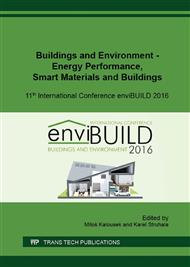[1]
Directive 2010/31/EU of the European Parliament and of the Council of 19 May 2010 on the energy performance of buildings (recast), Official Journal of the European Union 153 (2010) 13-35.
Google Scholar
[2]
A. Zöld, Zs. Szalay, What is missing from the concept of the new European Building Directive? Build. Environ. 42 (2007) 1761-1769.
DOI: 10.1016/j.buildenv.2005.12.003
Google Scholar
[3]
K. E. Thomsen, J. Rose, S. O. Aggerholm, Principles for nearly Zero-Energy Buildings, Buildings Performance Institute Europe, Brussels, (2011).
Google Scholar
[4]
R. Evins, A review of computational optimisation methods applied to sustainable building design, Renew. Sust. Energ. Rev. 22 (2013) 230-245.
DOI: 10.1016/j.rser.2013.02.004
Google Scholar
[5]
I. Kovacic, V. Zoller, Building life cycle optimization tools for early design phases, Energy 92 (2014) 409-419.
DOI: 10.1016/j.energy.2015.03.027
Google Scholar
[6]
S. Attia, M. Hamdy, W. O'Brien, S. Carlucci, Assessing gaps and needs for integrating building performance optimization tools in net zero energy buildings design, Energ. Buildings 60 (2013) 110-124.
DOI: 10.1016/j.enbuild.2013.01.016
Google Scholar
[7]
A. Hollberg, J. Ruth, LCA in architectural design-a parametric approach, Int. J. Life Cycle Ass. 21 (2016) 943-960.
DOI: 10.1007/s11367-016-1065-1
Google Scholar
[8]
H. Kreiner, A. Passer, H. Wallbaum, A new systemic approach to improve the sustainability performance of office buildings in the early design stage, Energ. Buildings 109 (2015) 385-396.
DOI: 10.1016/j.enbuild.2015.09.040
Google Scholar
[9]
C. Zhao, L. Li, Exploring a preferable workflow for conducting LCA in a BIM environment From a perspective of a construction company, Chalmers University of Technology, Gothenburg, (2015).
Google Scholar
[10]
Information on http: /www. e4haz. hu.
Google Scholar
[11]
RIBA Plan of Work, Royal Institute of British Architects, London, (2013).
Google Scholar
[12]
T. Csoknyai, Zs. Szalay, N. Stefler-Hess, Design of an energy efficient single family house with architectural and HVAC optimization, Wienerberger zRt, Budapest, (2012).
Google Scholar
[13]
ISO 14040 Environmental management - Life cycle assessment - Principles and framework, International Organization for Standardization, Geneva, (2006).
Google Scholar
[14]
ISO 14044 Environmental management - Life cycle assessment - Requirements and guidelines, International Organization for Standardization, Geneva, (2006).
Google Scholar
[15]
Ecoinvent data v1. 3 and final reports ecoinvent 2000, Swiss Centre for Life Cycle Inventories, Dübendorf, (2005).
Google Scholar
[16]
A tárca nélküli miniszter 7/2006. (V. 24. ) TNM rendelete az épületek energetikai jellemzőinek meghatározásáról, Magyar Közlöny 62 (2006) 5134-5175.
Google Scholar
[17]
EN 15978 Sustainability of construction works - Assessment of environmental performance of buildings - Calculation method, European Committee for Standardization, Brussels, (2011).
Google Scholar


